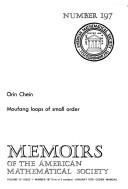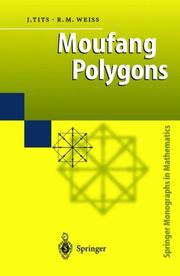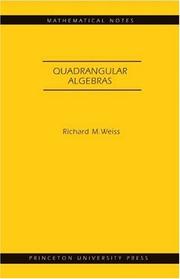| Listing 1 - 10 of 16 | << page >> |
Sort by
|
Book
Year: 1969 Publisher: Mainz: Hase und Koehler,
Abstract | Keywords | Export | Availability | Bookmark
 Loading...
Loading...Choose an application
- Reference Manager
- EndNote
- RefWorks (Direct export to RefWorks)
Book
ISBN: 9781470451011 1470451018 Year: 2022 Publisher: Providence, RI : American Mathematical Society,
Abstract | Keywords | Export | Availability | Bookmark
 Loading...
Loading...Choose an application
- Reference Manager
- EndNote
- RefWorks (Direct export to RefWorks)

ISBN: 0821821970 Year: 1978 Publisher: Providence (R.I.): American Mathematical Society
Abstract | Keywords | Export | Availability | Bookmark
 Loading...
Loading...Choose an application
- Reference Manager
- EndNote
- RefWorks (Direct export to RefWorks)
Group theory --- Moufang loops --- Loops, Moufang --- Loops (Group theory) --- Moufang loops.
Book
ISBN: 9783037191101 3037191104 Year: 2012 Publisher: Zürich European Mathematical Society
Abstract | Keywords | Export | Availability | Bookmark
 Loading...
Loading...Choose an application
- Reference Manager
- EndNote
- RefWorks (Direct export to RefWorks)
Book
ISBN: 9781470435547 1470435543 Year: 2019 Publisher: Providence, RI : American Mathematical Society,
Abstract | Keywords | Export | Availability | Bookmark
 Loading...
Loading...Choose an application
- Reference Manager
- EndNote
- RefWorks (Direct export to RefWorks)
"A Moufang set is essentially a doubly transitive permutation group such that each point stabilizer contains a normal subgroup which is regular on the remaining vertices; these regular normal subgroups are called the root groups, and they are assumed to be conjugate and to generate the whole group. It has been known for some time that every Jordan division algebra gives rise to a Moufang set with abelian root groups. We extend this result by showing that every structurable division algebra gives rise to a Moufang set, and conversely, we show that every Moufang set arising from a simple linear algebraic group of relative rank one over an arbitrary field k of characteristic different from 2 and 3 arises from a structurable division algebra. We also obtain explicit formulas for the root groups, the T-map and the Hua maps of these Moufang sets. This is particularly useful for the Moufang sets arising from exceptional linear algebraic groups"--
Lie algebras. --- Jordan algebras. --- Linear algebraic groups. --- Lie, Algèbres de. --- Jordan, Algèbres de. --- Groupes algébriques linéaires. --- Division algebras. --- Moufang loops. --- Combinatorial group theory. --- Algèbre à division --- Moufang, Boucles de --- Algèbres de Jordan --- Théorie combinatoire des groupes --- Division algebras --- Moufang loops --- Jordan algebras --- Combinatorial group theory --- Combinatorial groups --- Groups, Combinatorial --- Combinatorial analysis --- Group theory --- Algebra, Abstract --- Algebras, Linear --- Loops, Moufang --- Loops (Group theory) --- Algebras, Division --- Algebraic fields --- Quasigroups --- Rings (Algebra)
Book
ISBN: 9781470436223 1470436221 Year: 2019 Publisher: Providence American Mathematical Society
Abstract | Keywords | Export | Availability | Bookmark
 Loading...
Loading...Choose an application
- Reference Manager
- EndNote
- RefWorks (Direct export to RefWorks)
Ordered algebraic structures. --- Lie groups. --- Lie algebras. --- Lie, Algèbres de. --- Lie, Groupes de. --- Structures algébriques ordonnées. --- Moufang loops. --- Cayley numbers (Algebra). --- Cayley numbers (Algebra) --- Moufang loops --- Cayley octave (Algebra) --- Cayley's numbers (Algebra) --- Cayley's octave (Algebra) --- Octonions --- Cayley algebras --- Loops, Moufang --- Loops (Group theory)

ISSN: 14397382 ISBN: 3540437142 3642078338 366204689X 9783540437147 Year: 2002 Publisher: New York : Springer,
Abstract | Keywords | Export | Availability | Bookmark
 Loading...
Loading...Choose an application
- Reference Manager
- EndNote
- RefWorks (Direct export to RefWorks)
This book gives the complete classification of Moufang polygons, starting from first principles. In particular, it may serve as an introduction to the various important algebraic concepts which arise in this classification including alternative division rings, quadratic Jordan division algebras of degree three, pseudo-quadratic forms, BN-pairs and norm splittings of quadratic forms. This book also contains a new proof of the classification of irreducible spherical buildings of rank at least three based on the observation that all the irreducible rank two residues of such a building are Moufang polygons. In an appendix, the connection between spherical buildings and algebraic groups is recalled and used to describe an alternative existence proof for certain Moufang polygons.
Moufang loops --- Buildings (Group theory) --- Moufang, Boucles de --- Immeubles (Théorie des groupes) --- Moufang loops. --- Graph theory --- Graph theory. --- Buildings (Group theory). --- Immeubles (Théorie des groupes) --- Geometry. --- Algebra. --- Discrete mathematics. --- Algebraic geometry. --- Group theory. --- Combinatorics. --- Discrete Mathematics. --- Algebraic Geometry. --- Group Theory and Generalizations. --- Combinatorics --- Algebra --- Mathematical analysis --- Groups, Theory of --- Substitutions (Mathematics) --- Algebraic geometry --- Geometry --- Discrete mathematical structures --- Mathematical structures, Discrete --- Structures, Discrete mathematical --- Numerical analysis --- Mathematics --- Euclid's Elements
Book
ISBN: 1400874017 Year: 2015 Publisher: Princeton : Princeton University Press,
Abstract | Keywords | Export | Availability | Bookmark
 Loading...
Loading...Choose an application
- Reference Manager
- EndNote
- RefWorks (Direct export to RefWorks)
Descent in Buildings begins with the resolution of a major open question about the local structure of Bruhat-Tits buildings. The authors then put their algebraic solution into a geometric context by developing a general fixed point theory for groups acting on buildings of arbitrary type, giving necessary and sufficient conditions for the residues fixed by a group to form a kind of subbuilding or "form" of the original building. At the center of this theory is the notion of a Tits index, a combinatorial version of the notion of an index in the relative theory of algebraic groups. These results are combined at the end to show that every exceptional Bruhat-Tits building arises as a form of a "residually pseudo-split" Bruhat-Tits building. The book concludes with a display of the Tits indices associated with each of these exceptional forms.This is the third and final volume of a trilogy that began with Richard Weiss' The Structure of Spherical Buildings and The Structure of Affine Buildings.
Buildings (Group theory) --- Combinatorial geometry. --- Geometric combinatorics --- Geometrical combinatorics --- Combinatorial analysis --- Discrete geometry --- Theory of buildings (Group theory) --- Tits's theory of buildings (Group theory) --- Linear algebraic groups --- Bruhat-Tits building. --- Clifford invariant. --- Coxeter diagram. --- Coxeter group. --- Coxeter system. --- Euclidean plane. --- Fundamental Theorem of Descent. --- Moufang building. --- Moufang condition. --- Moufang polygon. --- Moufang quadrangle. --- Moufang set. --- Moufang structure. --- Pfister form. --- Structure Theorem. --- Tits index. --- abelian group. --- absolute Coxeter diagram. --- absolute Coxeter system. --- absolute rank. --- affine building. --- algebraic group. --- anisotropic pseudo-quadratic space. --- anisotropic quadratic space. --- anti-isomorphism. --- apartment. --- arctic region. --- automorphism. --- bilinear form. --- biquaternion division algebra. --- building. --- canonical isomorphism. --- chamber. --- compatible representation. --- descent group. --- descent. --- discrete valuation. --- exceptional Moufang quadrangle. --- exceptional quadrangle. --- finite dimension. --- fixed point building. --- fixed point theory. --- gem. --- generalized quadrangle. --- hyperbolic plane. --- hyperbolic quadratic module. --- hyperbolic quadratic space. --- involutory set. --- isomorphism. --- isotropic quadratic space. --- length function. --- non-abelian group. --- parallel residues. --- polar space. --- projection map. --- proper indifferent set. --- proper involutory set. --- pseudo-quadratic space. --- pseudo-split building. --- quadratic form. --- quadratic module. --- quadratic space. --- quaternion division algebra. --- ramified quadrangle. --- ramified quaternion division algebra. --- ramified separable quadratic extension. --- relative Coxeter diagram. --- relative Coxeter group. --- relative Coxeter system. --- relative rank. --- residual quadratic spaces. --- residue. --- root group sequence. --- root. --- round quadratic space. --- scalar multiplication. --- semi-ramified quadrangle. --- separable quadratic extension. --- simplicial complex. --- special vertex. --- spherical building. --- split quadratic space. --- standard involution. --- subbuilding of split type. --- subbuilding. --- tamely ramified division algebra. --- thick building. --- thin T-building. --- trace map. --- trace. --- unramified quadrangle. --- unramified quadratic space. --- unramified quaternion division algebra. --- unramified separable quadratic extension. --- vector space. --- vertex. --- weak isomorphism. --- wild quadratic space.

ISBN: 1282129465 9786612129469 1400826942 9781400826940 0691124604 9780691124605 9781282129467 6612129468 Year: 2009 Publisher: Princeton, NJ
Abstract | Keywords | Export | Availability | Bookmark
 Loading...
Loading...Choose an application
- Reference Manager
- EndNote
- RefWorks (Direct export to RefWorks)
This book introduces a new class of non-associative algebras related to certain exceptional algebraic groups and their associated buildings. Richard Weiss develops a theory of these "quadrangular algebras" that opens the first purely algebraic approach to the exceptional Moufang quadrangles. These quadrangles include both those that arise as the spherical buildings associated to groups of type E6, E7, and E8 as well as the exotic quadrangles "of type F4" discovered earlier by Weiss. Based on their relationship to exceptional algebraic groups, quadrangular algebras belong in a series together with alternative and Jordan division algebras. Formally, the notion of a quadrangular algebra is derived from the notion of a pseudo-quadratic space (introduced by Jacques Tits in the study of classical groups) over a quaternion division ring. This book contains the complete classification of quadrangular algebras starting from first principles. It also shows how this classification can be made to yield the classification of exceptional Moufang quadrangles as a consequence. The book closes with a chapter on isotopes and the structure group of a quadrangular algebra. Quadrangular Algebras is intended for graduate students of mathematics as well as specialists in buildings, exceptional algebraic groups, and related algebraic structures including Jordan algebras and the algebraic theory of quadratic forms.
Forms, Quadratic. --- Algebra. --- Mathematics --- Mathematical analysis --- Quadratic forms --- Diophantine analysis --- Forms, Binary --- Number theory --- Algebra over a field. --- Algebraic group. --- Associative property. --- Axiom. --- Classical group. --- Clifford algebra. --- Commutator. --- Defective matrix. --- Division algebra. --- Fiber bundle. --- Geometry. --- Isotropic quadratic form. --- Jacques Tits. --- Jordan algebra. --- Moufang. --- Non-associative algebra. --- Polygon. --- Precalculus. --- Projective plane. --- Quadratic form. --- Simple Lie group. --- Subgroup. --- Theorem. --- Vector space.
Book
ISBN: 9780691136592 0691136599 9780691138817 0691138818 9786612458361 1282458361 1400829054 9781400829057 9781282458369 6612458364 Year: 2008 Volume: 168 Publisher: Princeton, NJ
Abstract | Keywords | Export | Availability | Bookmark
 Loading...
Loading...Choose an application
- Reference Manager
- EndNote
- RefWorks (Direct export to RefWorks)
In The Structure of Affine Buildings, Richard Weiss gives a detailed presentation of the complete proof of the classification of Bruhat-Tits buildings first completed by Jacques Tits in 1986. The book includes numerous results about automorphisms, completions, and residues of these buildings. It also includes tables correlating the results in the locally finite case with the results of Tits's classification of absolutely simple algebraic groups defined over a local field. A companion to Weiss's The Structure of Spherical Buildings, The Structure of Affine Buildings is organized around the classification of spherical buildings and their root data as it is carried out in Tits and Weiss's Moufang Polygons.
Buildings (Group theory) --- Moufang loops --- Automorphisms --- Affine algebraic groups --- Moufang loops. --- Automorphisms. --- Affine algebraic groups. --- Algebraic groups, Affine --- Loops, Moufang --- Theory of buildings (Group theory) --- Tits's theory of buildings (Group theory) --- Group schemes (Mathematics) --- Group theory --- Symmetry (Mathematics) --- Loops (Group theory) --- Linear algebraic groups --- Buildings (Group theory). --- Addition. --- Additive group. --- Additive inverse. --- Algebraic group. --- Algebraic structure. --- Ambient space. --- Associative property. --- Automorphism. --- Big O notation. --- Bijection. --- Bilinear form. --- Bounded set (topological vector space). --- Bounded set. --- Calculation. --- Cardinality. --- Cauchy sequence. --- Commutative property. --- Complete graph. --- Complete metric space. --- Composition algebra. --- Connected component (graph theory). --- Consistency. --- Continuous function. --- Coordinate system. --- Corollary. --- Coxeter group. --- Coxeter–Dynkin diagram. --- Diagram (category theory). --- Diameter. --- Dimension. --- Discrete valuation. --- Division algebra. --- Dot product. --- Dynkin diagram. --- E6 (mathematics). --- E7 (mathematics). --- E8 (mathematics). --- Empty set. --- Equipollence (geometry). --- Equivalence class. --- Equivalence relation. --- Euclidean geometry. --- Euclidean space. --- Existential quantification. --- Free monoid. --- Fundamental domain. --- Hyperplane. --- Infimum and supremum. --- Jacques Tits. --- K0. --- Linear combination. --- Mathematical induction. --- Metric space. --- Multiple edges. --- Multiplicative inverse. --- Number theory. --- Octonion. --- Parameter. --- Permutation group. --- Permutation. --- Pointwise. --- Polygon. --- Projective line. --- Quadratic form. --- Quaternion. --- Remainder. --- Root datum. --- Root system. --- Scientific notation. --- Sphere. --- Subgroup. --- Subring. --- Subset. --- Substructure. --- Theorem. --- Topology of uniform convergence. --- Topology. --- Torus. --- Tree (data structure). --- Tree structure. --- Two-dimensional space. --- Uniform continuity. --- Valuation (algebra). --- Vector space. --- Without loss of generality.
| Listing 1 - 10 of 16 | << page >> |
Sort by
|

 Search
Search Feedback
Feedback About UniCat
About UniCat  Help
Help News
News